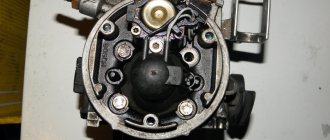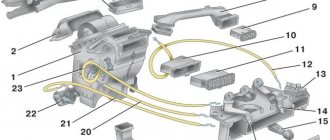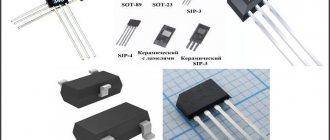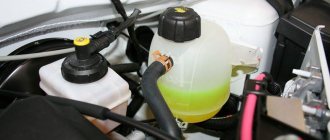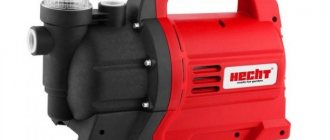A modern car is now equipped with a variety of active safety systems, the list of which is growing every year. These also include a system to prevent wheel locking during braking - ABS (Anti-lock braking system).
ABS is one of the very first safety systems that began to be used on a car, and it is now found on almost all cars, from budget categories to premium ones.
Let's briefly consider the purpose of ABS - this system is needed so that the wheels do not lock during braking, but continue to rotate, albeit at a slower rate.
Thanks to this, the grip of the wheel on the road surface is not lost and the likelihood of the car skidding is completely eliminated, the car remains fully controlled by the driver.
ABS has been used in vehicles for a long time and has proven its effectiveness more than once.
This system works simply. There is an electronic unit that controls the deceleration rate of each wheel. And if one of them stops faster than others, the block reduces the force of fluid pressure in the brake caliper on this particular wheel, that is, the brake mechanism begins to act less.
You can read more about the ABS device and other information on this system here.
What is the ABS sensor for?
It is stated above that the ABS unit, popularly called the “brains” of the braking system, controls the speed of rotation of the wheels, so the design of this system could not be done without sensors.
They are the “sense organs” of this system and based on their readings the ABS functions.
The first anti-lock braking system used only one sensor, which was installed in the axle of rear-wheel drive cars.
But as ABS has improved, their number has increased; modern cars already use 4 sensors. This allows the system to monitor the rotation speed of each wheel individually.
Brand selection
Equipment from reliable brands will always be more reliable and durable, especially sensors operating in rather difficult conditions. The best choice, as always, will be original (OEM) parts that are fully compatible with other components.
Reliable and durable automotive sensors today are produced by manufacturers Bosch (Germany), Delphi (USA) and Textar (Germany). By the way, ABS systems were developed by Bosch, which became a pioneer in this area.
The most popular brands offering the optimal combination of price and quality are JP Group (Denmark), Optimal (Germany) and ABS (Netherlands). This is not an elite product, but it is also quite reliable.
Inexpensive sensors, which, despite the budget price, will work normally, are produced by AutoMega, Dello, Topran (all three brands are of German origin). If you need to save money, it is better to buy products from these brands.
Types of sensors
There are three types of such elements, differing in their operating principle. The most common passive sensors are induction type.
The essence of their work comes down to a change in voltage due to the influence of a magnetic field. Their main disadvantage is the inability to determine the speed of rotation of the wheel at very low speeds.
The remaining two types are active.
One of them is magnetoresistive (rare). The principle of its operation is based on the magnetoresistive effect - the property of a semiconductor to change the trajectory of electrons when exposed to a magnetic field.
The second type of active sensor uses the Hall effect, in which electrons on a semiconductor wafer move to its edges when the magnetic field changes.
Sensor Features
There are several significant differences between passive and active types. They are called passive because they do not require voltage to operate; such a sensor itself generates electrical impulses, to which the electronic unit reacts. Active elements require voltage to be applied to them.
Passive elements are very simple in design and are very reliable. That's why they are so common, despite their shortcomings.
Active types of sensors use microcircuits in the design, which complicates the element and makes it more vulnerable. But they are highly accurate and do their job even at low speeds.
Since all types of sensors operate under the influence of a magnetic field, it alone is not enough in the design; another element is needed to which it would react.
The induction (passive) type uses a ferromagnetic alloy pulse gear ring mounted on the drive hub or shaft, as well as on the steering axle. Previously, it could also be mounted on the bevel gears of the main drive.
In active types, a magnetic pulse ring is used. In the case of a magnetoresistive sensor, this ring is divided into alternating sectors with permanent magnets of different polarities.
But the Hall sensor uses a regular magnetic ring, without any sectors, integrated into the wheel bearing.
Inductive type element design
Since inductive sensors are the most common, their design will be considered in the future.
Such a sensor consists of an inductive coil, inside of which a magnetic core is placed. It is installed next to the toothed impulse ring, but so that there is a certain gap between them.
When the wheel rotates, the ring teeth pass through the magnetic field created by the core, which affects the magnetic flux, causing the alternating voltage value in the coil winding to change.
As a result, the speed of rotation of the wheel, and with it the pulse ring, affects the frequency and amplitude of oscillations of the output voltage on the coil. These parameters are fed to the “brains”, as a result of which they estimate the speed of deceleration of the wheel.
Problems with at least one of the ABS sensors can lead to a complete shutdown of the system. And although the braking system on the car will work, you can forget about the braking efficiency and safety that ABS provided.
Summarizing
It has been established that a properly performed check of the ABS sensor with a tester is the primary task when repairing the system. You can use any convenient testing method, but you should always remember that diagnostics alone will not solve the problem - you will have to replace the device or “repair” the electrical wires. In order for the ABS to perform its task during braking, it is very important to monitor the condition of the sensors, checking, repairing and replacing them in a timely manner. Let's hope that our review and this video can help you carry out this “operation” yourself.
If any problems occur in the operation of the vehicle, the driver is faced with certain problems. These can be both serious breakdowns and minor faults that allow the car to be used in the future. Now we will talk about what the ABS sensor is, where it is located and how it is checked.
Causes of sensor malfunction
The induction sensor is characterized by its simple design and high reliability; malfunctions with it occur very rarely. The problem most often lies in the wiring through which signals are sent to the control unit.
Since the sensors and their wiring are located directly next to the wheels, over time the circuit may break or short out. Often, sensor failures occur due to oxidation of the contacts.
Due to the fact that after turning on the ignition on a car, ABS always undergoes self-diagnosis, during which the condition of all elements of the system is assessed, it is quite simple to identify problems with the sensors; if they occur, the warning light will constantly light up on the dashboard.
In total, there are 4 types of system behavior when a malfunction is detected:
- Self-diagnosis detects an error and ABS is disabled. This may be a sign of an error in the control unit, or a break in the wiring coming from the sensor;
- The system undergoes diagnostics, during which no problems are detected, but after this the ABS is turned off. This result usually results from problems with the wiring going to the sensors (oxidation, open circuit, short circuit, etc.);
- Self-diagnosis detects an error, but the system does not turn off and continues to operate. This usually indicates a break in the wiring on one of the sensors;
- ABS does not turn on. This can happen due to a broken wiring, or because the impulse ring is damaged, chipped or broken. This result can also be produced by a heavily worn hub bearing, which is why there is significant play in it.
Since malfunction of ABS often occurs due to wiring, it is quite simple to identify a faulty element and all you need is a multimeter.
Of course, it is better to check using an oscilloscope, since such a device makes it possible to visually assess the amplitude and frequency of voltage fluctuations in the sensor, but not everyone has one.
Next, we’ll figure out how to check the ABS sensor on different cars, although in general the procedure is the same, despite the fact that any type of sensor can be used on different models.
What do drivers say about it?
The controversy continues to this day. Conservative drivers of older cars argue that the ABS system is not something necessary. They are right to some extent, because only the driver can ensure complete safety on the road - electronics only provide him with a little help. However, ask yourself this question: how do you brake? Probably with intermittent soft pedal presses. This is an imitation of the operation of the anti-lock braking system, which makes up to 15 such “presses” per second.
Inexperienced drivers may be confused by a slight crackling sound in the cabin, as well as the jolting of the brake pedal that accompanies the operation of ABS. There is nothing to be afraid of here - the system is absolutely working and regularly regulates the flow of brake fluid.
The results of many tests of the ABS system show that it does not seriously affect the length of the braking distance. The effect on handling is only positive. If there is no ABS, the driver takes on all the difficulties of controlling the vehicle when braking. Not every specialist can handle a car in an emergency - electronics still react much faster than a person.
Check on Ford Focus 2
First, let's look at how the test is carried out on a Ford Focus 2. This car uses a Hall effect sensor and is located in the upper part of the wheel hub. It is easy to detect - just remove the wheel, unscrew and move the caliper to the side, and also remove the brake disc.
Before starting the inspection, be sure to check the tire pressure. It must be the same in all wheels, otherwise the pressure difference may affect the performance of the system.
To check the sensor on Focus 2, for ease of access, you should jack up and remove the wheel from the side being tested.
Next, disconnect the block of wires coming from the sensor. We visually assess the condition of the braid and wires; they should not show abrasions or other types of damage.
At the first stage, we check the resistance. To do this, switch the multimeter to ohmmeter mode and connect its probes to the terminals in the block.
On Focus 2, the sensor resistance when measured should be in the region of 1.3-1.4 kOhm.
But there is one nuance that is important to consider. During measurements, you should knead the wire, especially at bends.
The fact is that at the point where the wire is broken, the copper conductors can come into contact, and therefore the sensor can show normal resistance. And during crumpling and bending, contact is broken.
If the readings do not match, a measurement should be taken at the input of the wires to the sensor. This will reveal whether the problem lies in the sensor itself, or just in the wires.
If, when checking the resistance near the element, a discrepancy in resistance remains, then the sensor must be replaced.
In some cases, the cause of the problems lies in contamination of the semiconductor platinum of the Hall element. Therefore, you should remove the sensor itself and clean it.
In addition to the sensor wiring, you should also check the entire circuit for damage. To do this, you need to disconnect the wire block from the control unit.
Then we find out from the technical documentation for the car which terminals on the block correspond to which sensor, after which we connect a multimeter to the necessary connectors and measure the resistance.
If it does not meet the required parameters, you should look for a break in the area from the control unit to the sensor connection block.
Faults such as breaks or short circuits can be treated by replacing the wires. But if the element itself malfunctions, it is replaced.
ABS characteristics
What it is?
Diagram of the ABS system with the location of all components
ABS or anti-lock braking system is a system designed to prevent a vehicle's wheels from locking during braking. The main purpose of this unit is to maintain vehicle stability and controllability. As practice shows, braking distances with an ABS system are almost always shorter than without it.
Today, the unit is one of the most complex braking systems; ABS may include:
- traction control system;
- electronic vehicle stability control unit;
- emergency braking assistance mechanism.
In general, the system includes a control unit, a hydraulic device, wheel brake elements, as well as speed sensors. As you might guess, the main component of any system is a block designed to receive pulses from wheel speed sensors and evaluate their performance. The information received by the unit is fully checked by the system, as a result the device determines the degree of wheel slip. The received data is transmitted in the form of signals to the valves of the valve body designed to control the device.
Where is?
Sensor installation location on the rear wheel
The electronic unit itself can be located anywhere - everything here depends solely on the manufacturer. As for the wheel speed sensor, the ABS sensor is located on the wheel hub. Its performance and resistance can be determined with a special tester - a multimeter, but we will talk about this later.
How does it work?
The brake cylinder transmits pressure to apply pressure to the brake calipers. As a result of this force, the pads begin to press directly against the discs. Regardless of how hard the driver applies the brake, this pressure should always remain at the optimal level. The key advantage of any ABS system is that, as a result of analyzing the rotation speed of each wheel, it automatically selects the required pressure level. Accordingly, it prevents the wheels from locking, and during full braking, the system automatically regulates the pressure in the system.
Actually, this is the principle of the system’s performance. If the vehicle is equipped with all-wheel drive or rear-wheel drive, there will be only one ABS sensor - this regulator is installed on the rear axle differential. Data on the speed of rotation or blocking is transmitted from the nearest wheel, usually the right one, at the same time an impulse about what the pressure should be is transmitted to all wheels of the car.
Diagnostics of the ABS system using a tester
As for operating modes, there may be several of them.
The mechanism, which is controlled by magnetic valves, regardless of the manufacturer and brand of the vehicle, operates in several modes:
- When the inlet valve is open and the outlet valve is closed, the assembly will not prevent the pressure level from increasing.
- A corresponding impulse is transmitted to the inlet element, and the component will be closed; the pressure level in this case remains unchanged.
- Another mode - a signal about a decrease in pressure level is transmitted to the outlet component, and accordingly, the valve begins to open. At this time, the inlet component closes, the pressure level begins to drop as the check valve comes into operation.
As a result of the fact that the system operates in such modes, the process of increasing the pressure level is carried out in a stepwise manner. If any malfunctions occur, for example, in the operation of the front right speed sensor, the device simply goes back to work. In the future, the braking system functions without the participation of ABS. By the way, if the system or the front right wheel speed control fails, a signal will appear on the instrument panel warning the driver about a malfunction of the unit (the author of the video is Yakov Sokolov).
Diagnostic features for BMW E39
Next, let's look at the nuances of checking the ABS sensor on a BMW E39. This car already uses an induction element.
Diagnostics are carried out using the same methods as for Focus 2. That is, the resistance of the sensor, its wiring, as well as the circuit from the control unit are checked.
Since this car uses an induction type element, it is additionally possible to measure the output voltage.
To do this, switch the multimeter to voltmeter mode and connect it to the sensor wiring connectors.
Next, spin the wheel to approximately 50 rpm. In this case, the element being diagnosed will begin to generate electricity, the voltage of which should be around 2 V.
The best manufacturers
If you don’t know which company’s DSA is best to install on your car, then use the recommendations of specialists. Most often, they persuade drivers to use models from well-known brands. The latter value their reputation, so they supply only proven, high-quality devices to the domestic market.
Best manufacturers:
- StartVOLT (Russia);
- SAILING (China);
- BOSCH (Germany);
- ASAM (Romania);
- DELPHI (UK);
- Te Parts (Latvia);
- Nissan (Japan);
- Hyundai (South Korea);
- Febi (Germany).
Design nuances of Lada "Priora", "Kalina"
Now let’s figure out a little how to diagnose and replace Lada cars of the Priora and Kalina models. These cars were taken as an example because they use drum brakes at the rear, and above we looked at how work is carried out with sensors that work with disc mechanisms.
Checking the sensors on Kalina or Priora is completely identical to those described. But this sensor still needs to be found. The element is installed in the rear wall of the hub, and the impulse ring is located inside the mechanism, under the drum.
Therefore, in order to assess its condition, you will have to remove the drum from the car, and immediately under it you will see the ring, as well as the protruding part of the sensor, which passes through the technological hole in the brake pad.
That is, by checking the condition of the ring, you can immediately look at and clean the sensor itself from dirt. And then we measure the resistance of the sensor and the entire circuit up to the “brains”.
About braking efficiency
There is nothing wrong with ABS failure. The system only helps the driver to brake, and does not completely take over the work of the brakes. In the event of a malfunction, you should be prepared for possible difficulties in driving and the risk that the car will skid. The following has a serious impact on the course and braking distance:
- Tire condition;
- Condition of brake discs, pads and calipers;
- Condition of hydraulic brake drive elements;
- Vehicle suspension condition.
Obviously, a vehicle with parts in perfect condition not only drives well, but also stops well. Brakes and pads need to be taken seriously. The ABS system works better with disc brakes.
Features of the Opel Vectra sensor
Now let's go over the features of the Opel Vectra. And the main one lies in the fact that this sensor is made in the form of a ring and is mounted on the hub. Therefore, it is not difficult to check it again using a multimeter, but replacing it in case of damage is difficult, since you will have to remove the hub.
In general, by simply measuring the resistance, you can assess the condition of any ABS sensor, as well as its wiring.
Whatever element is used on the car, its resistance will vary in the range of 1.2-1.8 kOhm.
One of the main conditions for diagnostics is not only the resistance value, but the same resistance reading on all sensors.
Label: Sensors
Replacement instructions
Let's look at the process of replacing a Toyota ABS sensor on the rear axle. The car is placed on a level surface with the hand brake applied. To increase safety, chocks are placed under the wheels. At the same stage, you need to remove the negative terminal from the battery.
Next, the rear seats, threshold trim, and door seal are dismantled. You need to get to the connector. To do this, bend the clamps and pull off the trim near the shock absorber strut mount. Then disconnect the connector.
Next, the car is raised with a jack, and a block is placed under the bottom for safety. After this, you can unscrew and remove the wheel. The sensor is installed on a bracket. To replace the ABS sensor, you need to spray the bracket with liquid key and wait a little. Then unscrew the mounting bolt. By tapping the element, remove the sensor with a screwdriver.
Then you need to unscrew the fasteners holding the wire brackets. Two bolts on the arch, and one on the shock absorber strut. The wire should be pulled out into the interior.
Installation of the new device is carried out in the reverse order. This completes the operation. Sensors on other car models are changed using a similar scheme (replacing the Lancer ABS sensor is no exception).
